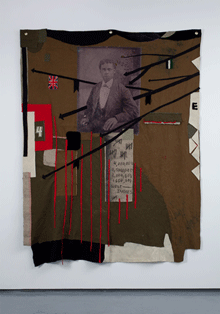
'UNTITLED' Blanket, 80 by 69.5 inches, 2009,
by Radcliffe Bailey, courtesy of the author and
Jack Shainman Gallery |
That collage can involve a lot more than bits of paper and glue is currently demonstrated at the Bates College Museum of Art. On view are 46 works predominantly drawn from “Remix: Selections from the International Collage Center,” which has been touring nationally since 2011, as well as a few loans. This is, however, far from a comprehensive overview of the medium. The nonprofit ICC was founded three years ago in Milton, Pennsylvania by Pavel Zoubok, proprietor of an eponymous gallery in Chelsea, New York, which specializes in collage, assemblage, and mixed media installations. Rather than a gathering of predictable names and styles, the personal nature of the collection’s origin — of one man’s devotion to and obsession with the medium — makes it vulnerable to criticism but also adds personality and interesting idiosyncrasy.
Criticism first. Judging by the accompanying catalogue, which includes the entire group of works touring as “Remix,” I suspect that at times, enthusiasm for the medium trumped aesthetic judgment and critical relevance. Moreover, many first-rate practitioners of the medium are not represented (I’m thinking of Anne Ryan and Fred Tomaselli in particular). Also, given the exhibit’s wide-ranging definition of collage, it seems surprising that only two works on view expand into assemblage. On the other hand, the collection’s obvious limitations offer an opportunity for personal, critical engagement instead of authoritative dictum.
Pablo Picasso’s 1912 “Still Life with Chair Caning” is generally considered the beginning of collage as art for its inclusion of printed oil cloth and rope. From this introduction of different registers of representation, combination of high and low art, and subversion of the unity of surface, collage came to embody a quintessentially modern experience of fragmentation and alienation. It has played a role in all major art movements since the early 20th century, and whatever the medium’s attraction was in those historical contexts, is also represented in “Remix,” though not necessarily by the original practitioners. The exhibition instead makes a strong and believable point for collage’s continued relevance.
Surrealistic combination of incongruent elements motivates John Stezaker’s juxtaposition of two film stills. Abstract expressionism valued collage for its gestural and compositional possibilities, which Vivian Springford explores in an arrangement of cut, water-colored paper. In an early (c. 1928) and intriguing collage by Hilla von Rebay, intricately trimmed bits of paper stand in for brushstrokes. Stas Orlovski’s mixed media image of a tilted tabletop covered with books recalls cubist concerns and Cézanne still lifes. And Dadaist socio-political commentary finds its echo in the feminist work of Mary Beth Edelson, while Radcliffe Bailey’s wallhanging evokes the complex and fragmenting nature of African-American enslavement.
Art historical parallels may not be intentional but simply evidence of the medium’s possibilities. Collage lends itself to obsession, layering of imagery, and association with the crafts of quilting, memorialization, and archiving of personal narratives. Examples of these approaches can be found throughout “Remix,” with the following standing out for me: Donna Sharett’s lacework of rose petals, beads, and hair that suggests Victorian mourning crafts; Judy Pfaff’s seamless integration of abstract and representational imagery; Aaron Wexler’s subtle intersection of printed, embossed, and painted paper into a meandering field of shapes, lines, and colors; and Max Greis’s video collage, which perfectly integrates various clips into a high-keyed narrative suffused with art historical references. Other collagist strategies represented include figuration, repetition, simultaneity, and the poetic construction of language.